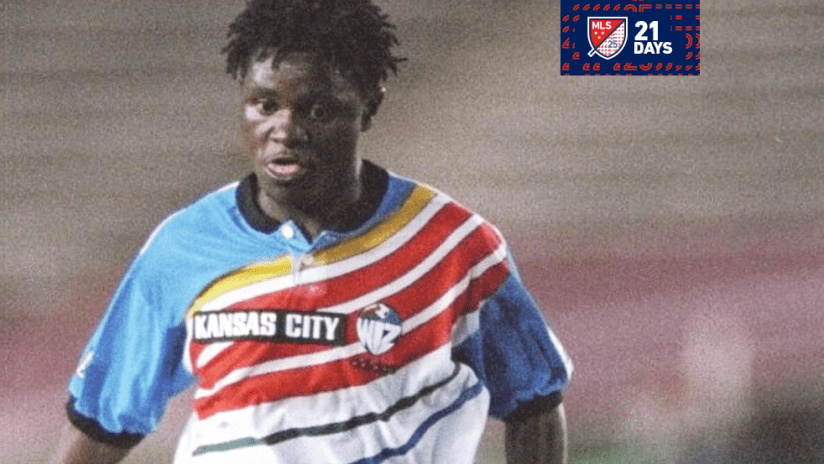EDITOR'S NOTE: Before you know it, February 29 will be here. That's the kickoff to the 25th season in Major League Soccer history and we're getting you ready for the 2020 campaign with the stories, personalities and questions that will leave their mark on the season to come.
My favorite MLS player I won’t ever see is Digital Takawira.
Honestly, I missed a lot of MLS players I would have liked to see. There are a couple of reasons for that, the first being that the league itself is older than me. The second is that — and get ready to roll your eyes here. Actually, go ahead and roll them back in your head for like 10 seconds and you won’t even have to read this next sentence — I DIDN’T START FOLLOWING THE LEAGUE UNTIL ATLANTA UNITED. There. There you go. I hope you ignored it. If not, feel free to use it as a reason to discredit any argument I make about MLS until the end of time. Being right about sports things is the dumbest thing to be right about anyway.
While that newness to the league does invalidate every opinion I will ever have about soccer, it also gives me a chance to look at the last 25 years in the same way you look at your parents’ high school yearbook photos. What might be embarrassing to them, is endlessly entertaining and endearing to me. It also allows me a chance to step back and marvel that they ever escaped that light blue tuxedo with a ruffled white shirt to become accomplished adults.
Look, football presents its early history with naval sea shanties playing in the background and hulking lineman talking about what an honor breaking every single one of their fingers for the team was. Baseball feels like a Civil War documentary. But large sums of MLS history — and I say this with love — could be accompanied by ironic techno music and papyrus font title cards. It’s wholly unique and it makes any of the sport’s successes over the last 25 years feel implausible, then remarkable. The history of the league is some early brushes with failure with minor wins sprinkled on top that turned into larger and larger wins as time went on while Jason Kreis hung out in the background.
The major moments that registered with soccer-illiterate kids like me are obviously crucial to the league’s history. Beckham, Adu and the Sounders inventing soccer all come to mind. But I think what makes MLS’s first 25 years special is that we were, and are, able to put the first 25 years of a league growing from nothing under a microscope in a way that baseball, football, basketball and hockey were able to avoid. The struggles of those leagues to exist successfully beyond their earliest years are documented, but very few of us were around to watch these leagues grow in real-time. MLS is the only major North American sports league where much of its beginnings were documentable in ways beyond telegram, black and white videos and newspaper articles written by dudes named Grantland.
At this very moment, you can still regularly interact with the people involved in the league’s earliest and most unpredictable days. And if you want to see up close how this thing nearly came burning to the ground and took the sport itself with it in a Tampa Bay Mutiny-sized black hole only to begin to thrive later on, you can.
For example: If I come across the phenomenal revelation that a team called the Kansas City Wiz once had a player named Digital Takawira who did a goal celebration called the “Digital Crawl” every time he scored in a football stadium with like 8,000 people in attendance, I know it won’t take much effort to find video.
Fast forward and 20,000 people regularly attend games in Kansas City at a soccer-specific stadium. On top of that, there are probably 10 people who played with Digital hanging out in the press box. Heck, one of them might actually be Digital.
On a very related note: Please, please sell/loan me your Digital Takawira jersey.
I didn’t know anything about the Wiz when Digital played, but I still feel some nostalgia for the incredible rainbow kits. In fact, I love all of the original MLS kits and branding because I believe I think those things might be the key to understanding how incredible it is to have anyone in attendance at all today.
The charter members of MLS had their identities determined by a marketing push for imagery that invoked the burgeoning skateboarding culture in the United States that existed apparently. Why skateboarding? Well, first off, 1995. Second and most importantly, the league wanted to follow a similar path as Japan’s recently launched J-League, where team uniforms were inspired by anime.
If anyone wants to make the Venn diagram that explains how skateboarding correlates to anime for American audiences in the 90’s, please be my guest. Can you imagine any other North American league having similar roots? Finding out that anime played a crucial part in the branding of MLS teams is like finding out that the Boston Red Sox were inspired by...well, anime.
This is what led us to the incredible marketing description of the Tampa Bay Mutiny’s iconic (?) logo that really could have been this entire piece on its own:
“A cyber-mutant from the dark blue depths of space...soccer reaching the fourth dimension.”
The players playing in the skateboarding kits had their worries. Plenty of leagues had come and gone. Quickly.
“Look, I am from soccer in the seventies and eighties, and as I said, I saw firsthand the demise of league after league,” original member of the New England Revolution, Alexi Lalas, said. “Whether it was indoor, outdoor, all different levels, all different geographies, that didn't succeed in the United States. I'll be honest with you, we were all conditioned to be waiting for that moment. That’s a traditional pessimism based on the history that existed in American soccer and American soccer players.”
Despite the well-earned pessimism, the league felt different enough to at least have a chance at changing the narrative.
“You were very cognizant and aware of how many leagues failed for various reasons,” Brian Dunseth, a longtime MLS veteran and rookie with the 1997 New England Revolution, said. “And yet here we were once again with another professional league. And it felt different because of the number of players from around the world that were coming out of a world cup not too long before that had committed to playing in the United States. We'd all committed to being part of what was kind of this crazy project.”
Even with an extra sense of reassurance behind the new league, it still felt like a “crazy project.” In many ways, the Mutiny’s early description of “soccer reaching the fourth dimension” feels prophetic for MLS.
And that goes beyond the fact that teams were called things like the “Dallas Burn” and had logos that I would describe as “Trogdor the Horse-inator.”

There were running shootouts, Goalie Wars, managers exploiting the rules to make four substitutions and players nicknamed Big Mama winning All-Star game MVPs and giving genuinely delightful acceptance speeches like...
“I’m very happy here because it is the first time I’m in the United States and I like the people and I’m very happy to play at this field because it’s fantastic that’s why I score so many goals and why I’m the Big Mama because I make the control all the fields, I make the control all the goals, that’s why I’m Big Mama. Thank you for everybody.”
This would have been 10,000 words if I could talk about nothing but the insanity of early MLS, the league’s eventual overcorrection from skateboard branding to uber-European names, to the eventual understanding that the European theft wasn’t all that bad as long as the supporter culture took the best parts of Europe’s fans and turned it into something uniquely their own.
The main thing though is that it all happened in the first place and we get to look back and revel in the splendor of the Digital Crawl performed in front of 8,000 people in a way that shouldn’t make followers of the league insecure, but more assured that this is all heading in the right direction.
From the perspective of someone who jumped in head-first on the back end of the first 25 years and who didn’t have a chance to experience the cavernous football stadiums and early pioneers like Roy Lassiter or Stern John running wild on the league, it’s hard to sympathize with any MLS inferiority complex longtime followers might have. Especially when embracing the elements that make so much of the past feel otherworldly has made discovering MLS so much fun.
And now we’re here. The league continues to grow, attendance continues to rise, talent is increasing and teams have bonafide roots in their cities and regions. Somehow. It’s something to be proud of for those who have been around since the beginning and something to enjoy the hell out of for those just coming into the fold.
“I know we kick ourselves for what we haven't done. We want more and sometimes we eat our own and all that kind of stuff in the soccer community,” Lalas said. “But I also think that at times you have to step back and pat yourself on the back for how far you've come. I mean, when you look at Major League Soccer and you look at the growth and the evolution and the history of it and you put it up against any other league in the world or any other sport in the world for that matter, it's come so far in such a short period of time. It's really unprecedented in terms of that.”
The growth is great. But a large part of me selfishly hopes things don’t become too polished on the field while the crowds and infrastructure grow off it. For now, anything can happen on the field at any time thanks to the randomness that other leagues tend to avoid. The parity is real and the players range from legitimate stars to recently graduated from Akron.
There’s too much soccer around the world where the outcome feels predetermined. MLS is and has, wonderfully, never been that. For the last 25 years, it’s been soccer stuck in the fourth dimension, and I hope it never leaves.











